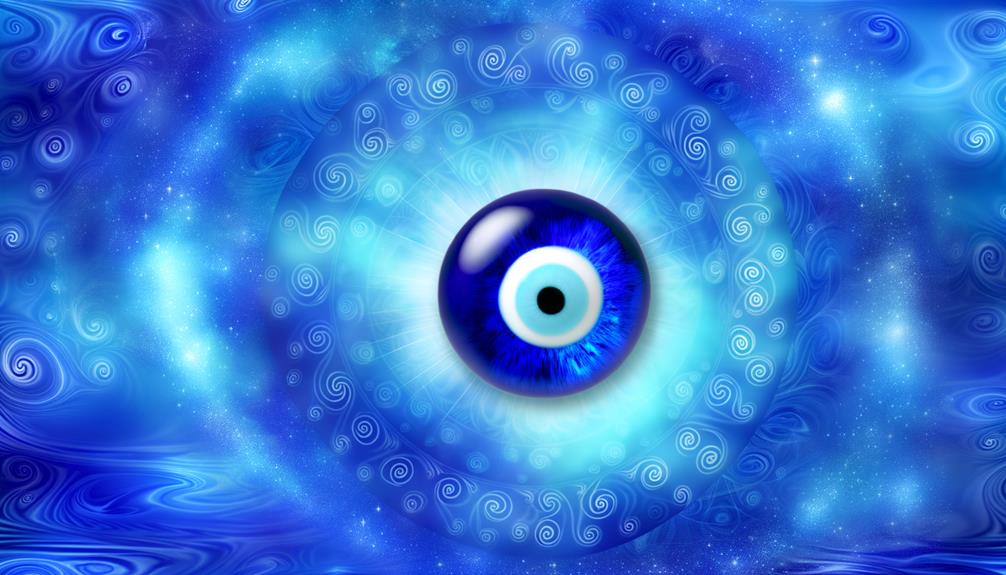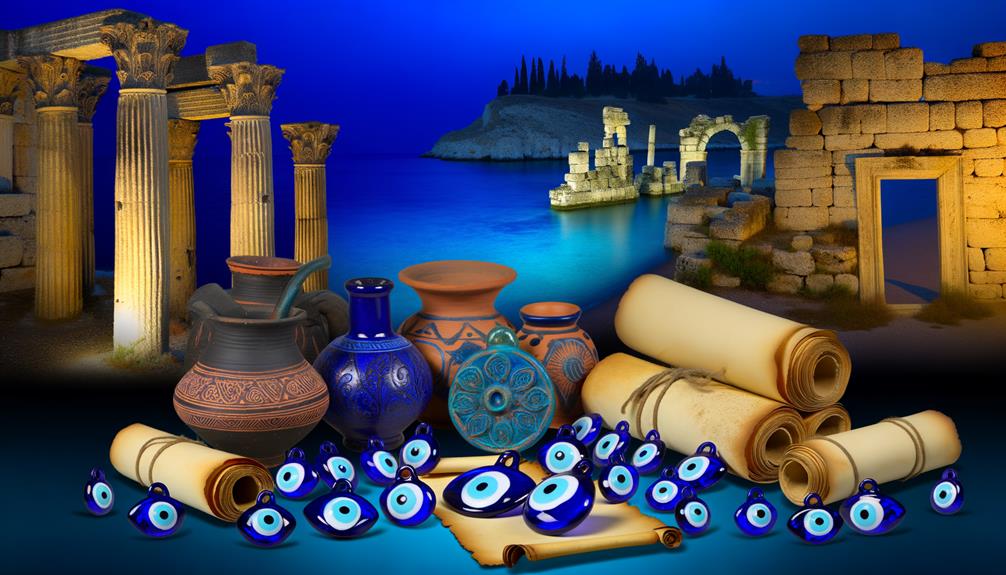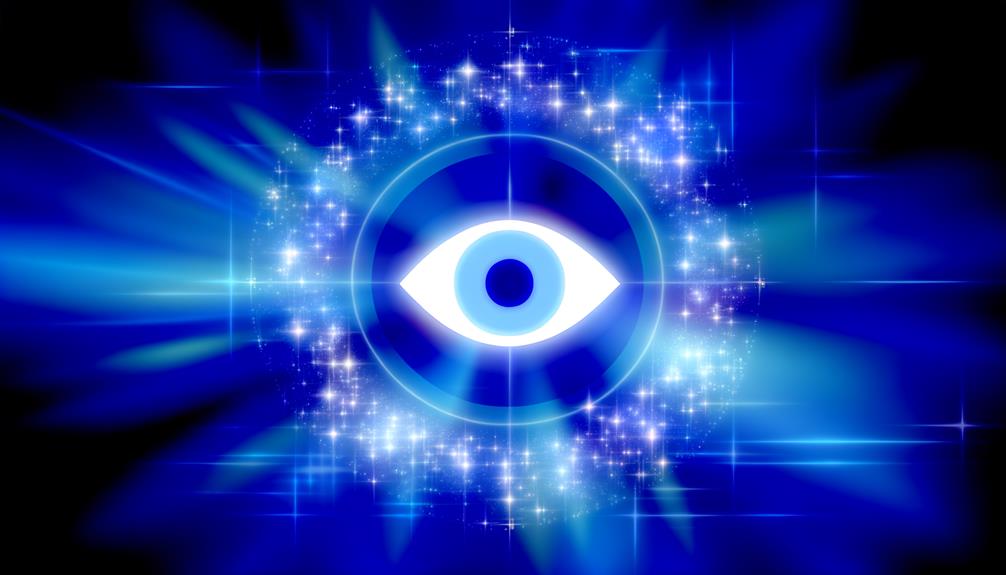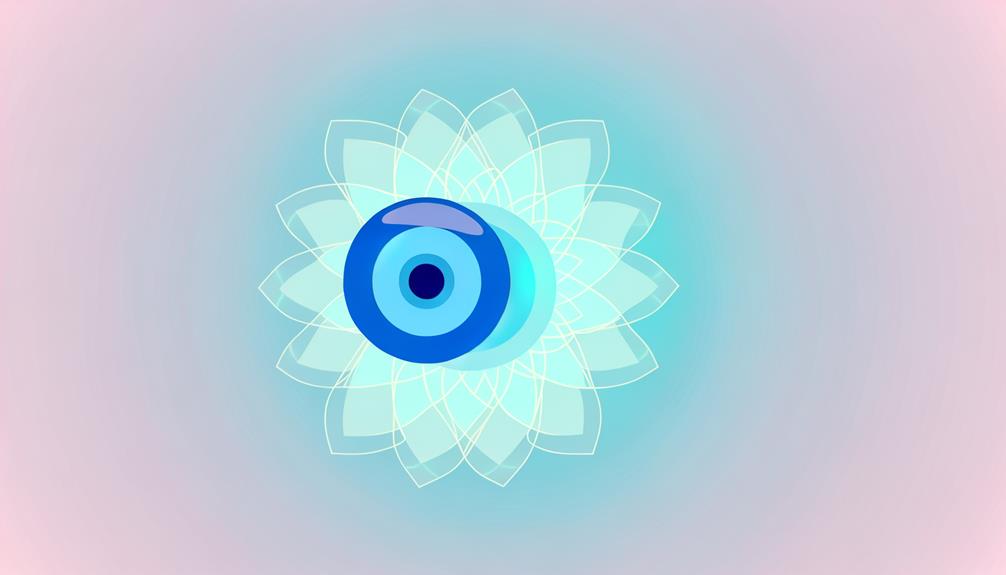Blue Evil Eye Meaning Spiritual: Protection and Awareness
The blue evil eye is a prominent spiritual symbol across various cultures, deeply revered for its protective qualities. Historically rooted in ancient civilizations like Mesopotamia and Greece, it deflects negative energies and malevolent intentions.
The blue color symbolizes serenity and calm, offering spiritual healing and emotional balance. Diverse traditions, from the Mediterranean to South Asia, employ it in daily rituals and personal adornments, ensuring well-being and security against envy and harm.
In modern times, its significance remains, woven into jewelry and digital symbols, reflecting a timeless quest for spiritual safeguarding and positive energy. Explore further to understand its rich cultural tapestry.

Blue Evil Eye Spiritual Meaning: Protection, Intuition, and Spiritual Awareness
| Symbolism | Meaning |
|---|---|
| Protection | Shields against envy, curses, and negative energy |
| Intuition | Enhances inner knowing and psychic sensitivity |
| Spiritual Awareness | Encourages mindfulness and heightened perception |
| Peace and Calm | Brings emotional balance and serenity |
| Divine Watchfulness | Symbolizes being guided and watched over by higher powers |
Origins and History

The origins and history of the blue evil eye trace back to ancient civilizations, where it emerged as a potent symbol of protection against malevolent forces.
Evidence of its use spans across Mesopotamia, Egypt, and Greece, indicating a shared belief in its defensive powers.
In these early societies, the blue evil eye was crafted from materials such as glass and clay, its vivid hue thought to deflect harmful intentions.
The symbol’s pervasive presence in various cultures suggests a universal human desire to ward off envy and misfortune.
Its continuity through millennia underscores its perceived efficacy and cultural importance.
Cultural Significance
The cultural significance of the blue evil eye spans across various societies, each imbuing it with unique meanings and traditions.
From ancient practices to contemporary interpretations, this symbol serves as both a protective talisman and a reflection of deeply rooted beliefs.
Understanding its historical roots and the symbolism attributed to it in different cultures offers a rich tapestry of human connection and shared values.
Historical Roots and Traditions
Tracing its origins back to ancient civilizations, the blue evil eye has long held a revered place in various cultural traditions as a potent symbol of protection and warding off malevolent forces. Embraced by societies ranging from Mesopotamia to Ancient Greece, the symbol’s historical roots are as diverse as they are profound.
| Civilization | Era | Significance |
|---|---|---|
| Mesopotamia | 3rd millennium BCE | Protection against envy and harm |
| Ancient Egypt | 16th century BCE | Amulet for safeguarding the living and dead |
| Ancient Greece | 6th century BCE | Believed to deflect negative energy |
| Ottoman Empire | 13th century CE | Used in jewelry to protect against curses |
These ancient practices underscore the enduring belief in the blue evil eye’s power to shield individuals from unseen dangers, fostering a sense of spiritual security across epochs.
Symbolism in Different Cultures
Across diverse cultures, the blue evil eye symbol is revered for its alleged ability to protect individuals from envy and harm.
In Mediterranean societies, it is often seen as a talisman warding off the malevolent glares believed to cause misfortune.
Middle Eastern traditions similarly hold that the blue evil eye can deflect negative energies, safeguarding personal well-being.
In South Asia, it is commonly integrated into daily life and rituals to shield against jealousy and malicious intents.
The symbolism transcends mere superstition, embodying a deep-seated cultural recognition of the human emotions of envy and the desire for protection.
This potent emblem underscores a shared human inclination towards seeking harmony and safety, resonating universally across geographical and cultural boundaries.
Modern-Day Interpretations
In contemporary society, the blue evil eye continues to hold significant cultural relevance, symbolizing protection and warding off negativity in both traditional and modern contexts.
Its presence is ubiquitous, appearing in jewelry, home décor, and fashion accessories. People of various backgrounds embrace it as a talisman of safety, transcending its origins to become a global emblem of spiritual safeguarding.
The blue evil eye’s modern-day interpretations also extend to digital spaces, where it is used in emojis and online avatars to convey a sense of spiritual resilience.
This enduring symbol reflects a collective yearning for security and positive energy, offering a tangible connection to ancient traditions while seamlessly integrating into contemporary lifestyles.
Symbolism and Color

The blue evil eye, revered across various cultures, serves not only as a protective talisman but also embodies profound spiritual and healing attributes.
Its rich hue is believed to channel potent protective energy, warding off malevolent forces.
Variations in cultural interpretations further enhance its significance, attributing unique spiritual and emotional healing properties to its symbolism.
Protective Energy Significance
Symbolically, the blue evil eye is believed to harness protective energy that wards off negative influences and harmful intentions. This ancient talisman, often depicted in a striking hue of blue, is thought to act as a shield against envious glances and malevolent thoughts.
The color blue itself is significant; it is associated with calmness, serenity, and depth, evoking the vastness of the sky and sea. This calming effect is thought to counteract negativity, fostering a balanced and peaceful environment.
In fundamental nature, the blue evil eye serves as a constant reminder to stay vigilant while promoting a sense of security and well-being. Its protective energy aims to safeguard both the wearer’s emotional and spiritual domains from unseen adversities.
Cultural Interpretations Variations
Drawing from a rich tapestry of cultural beliefs, the blue evil eye‘s symbolism and color interpretations vary considerably across different societies.
In Mediterranean cultures, it is commonly viewed as a protective talisman against envy and malevolent gazes. Within Turkish traditions, the blue hue represents the eye of a deity, providing a watchful safeguard over individuals.
In the Middle East, the color blue is believed to ward off evil spirits and attract positive energies. Greek traditions also hold similar beliefs, where the blue evil eye is thought to offer protection and bring good fortune.
Each cultural context imbues this symbol with unique meanings, yet the overarching theme remains its role as a shield against negative influences and malevolent forces.
Spiritual Healing Properties
Many believe the blue evil eye possesses powerful spiritual healing properties, with its vibrant hue symbolizing tranquility, protection, and inner peace. The color blue is often associated with the vastness of the sky and the depth of the ocean, evoking a sense of calm and serenity.
This symbolism extends to the evil eye, which is thought to ward off negative energy and bring about emotional balance. The following table highlights the key spiritual attributes associated with the blue evil eye:
| Attribute | Symbolism | Color Representation |
|---|---|---|
| Tranquility | Inner Calm | Blue |
| Protection | Safeguarding | Deep Blue |
| Inner Peace | Emotional Balance | Sky Blue |
This harmonious blend of meanings underlines the significance of the blue evil eye in spiritual practices. The spiritual significance of blue eyes is often believed to represent purity, protection, and a deep connection to the divine. Many cultures regard the blue evil eye as a powerful amulet that wards off negative energies and brings good fortune. By integrating these interpretations into their rituals, practitioners deepen their understanding of the force these symbols hold in their lives. The spiritual significance of blue light further enhances this connection, symbolizing clarity and enlightenment in various traditions. This ethereal glow is often associated with higher consciousness and intuition, guiding individuals toward their true path. By embracing both the blue evil eye and the spiritual significance of blue light, practitioners cultivate a holistic approach to their spiritual journey.
Protection Rituals
In the domain of spiritual practices, protection rituals involving the blue evil eye are deeply rooted in ancient traditions and are believed to ward off malevolent forces.
These rituals often include the use of talismans, amulets, or jewelry adorned with the blue evil eye symbol. Such items are commonly placed in homes, vehicles, or worn as personal adornments to create a protective barrier against negative energies.
Rituals may also encompass specific prayers, incense burning, or the use of protective herbs to enhance the efficacy of the blue evil eye.
Modern Interpretations

Contemporary perceptions of the blue evil eye symbolize a blend of cultural heritage and modern-day beliefs in spiritual protection. Many people believe that the blue tiger eye properties enhance clarity and intuition, making it a favored choice for those seeking guidance in their daily lives. This metaphysical stone is often used in meditation practices to promote calmness and focus, reinforcing its status as a powerful talisman against negativity. As a result, the vibrant blue hue not only captivates the eye but also serves as a reminder of the deeper connections between cultural traditions and personal well-being.
In today’s society, this ancient amulet transcends cultural boundaries, appealing to a global audience who seek its reputed protective qualities. The blue evil eye is often interpreted as a shield against negative energies and harmful intentions, serving as a spiritual safeguard in a fast-paced, interconnected world.
Its significance has evolved, intertwining with modern spirituality and wellness practices. This melding of tradition and contemporary thought reflects a collective yearning for security and harmony, bridging the gap between ancient wisdom and present-day life.
The blue evil eye continues to be a potent emblem of resilience and positive energy.
Wearing the Blue Evil Eye
Adorning oneself with the blue evil eye amulet is believed to offer both aesthetic appeal and spiritual protection, making it a meaningful accessory in various cultural contexts.
Traditionally, this talisman is thought to ward off negative energy, envy, and misfortune, thereby safeguarding the wearer’s well-being. Its vibrant blue hue is not merely decorative; it is spiritually significant, often symbolizing purity and the divine.
Commonly worn as jewelry—bracelets, necklaces, or rings—the blue evil eye is versatile, fitting seamlessly into modern fashion while retaining its protective qualities.
For many, wearing this amulet fosters a sense of security and connection to ancient traditions, blending beauty with a deep-rooted cultural legacy that spans generations.
Myths and Misconceptions

Despite its widespread appeal and revered status, the blue evil eye amulet is often surrounded by various myths and misconceptions that can obscure its true significance and cultural origins.
One prevalent myth is that the amulet itself possesses magical powers, rather than serving as a symbolic representation of protection.
Another misconception is that it is exclusive to one culture or religion, whereas it actually spans various traditions, including Mediterranean, Middle Eastern, and South Asian.
Additionally, some believe that wearing the amulet guarantees immunity from all harm, which oversimplifies its role as a protective charm.
Conclusion
The blue evil eye, steeped in ancient origins and rich cultural significance, continues to be a potent symbol of protection and spiritual vigilance.
Its varied symbolism, deeply influenced by color, transcends mere superstition, finding relevance in both historical and modern contexts.
Whether through traditional rituals or contemporary fashion, the blue evil eye remains a steadfast guardian, embodying a timeless belief in the power of spiritual defense against malevolent forces.
Consequently, its enduring allure persists across generations.






